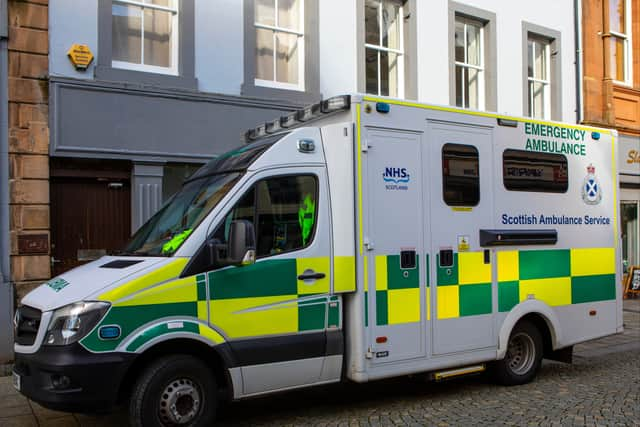Patients becoming critically ill while waiting for ambulances, figures show
and live on Freeview channel 276
Data released under freedom of information showed huge increases over the past five years in the number and response times for call-outs coded ‘purple’ or ‘red’ - where ambulances are expected to be on the scene within eight minutes.
The colour codes are based on a five-tier triage model introduced by the Scottish Ambulance Service (SAS) in November 2016, which grades incidents green, yellow, amber, red or purple based on risk.
Advertisement
Hide AdAdvertisement
Hide AdThe number of most urgent ‘purple’ 999 emergencies has doubled from 9,591 in 2018 to 19,558 last year, with 6,841 in the period from January to the end of April this year deemed to be life-threatening.


From 2018 to 2020, there were fewer than five ‘purple’ incidents a year where the response time exceeded 60 minutes.
By last year this had climbed to 22, with a further nine in the first four months of 2022.
For the next most serious ‘red’ call outs, the number of incidents where the response time exceeded 60 minutes has soared from 111 in 2018 to 510 last year, and 783 alone in January to the end of April this year.
Advertisement
Hide AdAdvertisement
Hide AdThere has also been a steady increase in the annual total of ‘red’ incidents, from 67,535 in 2018 to 93,483 last year, and 28,782 by the end of April this year.
Average percentile response times are all up but there are fears that the severe pressures now engulfing the ambulance service are leading to some calls being coded at a lower risk threshold than they deserve, only to be escalated later.
Paramedic Jamie McNamee, a Unite convenor who first joined the Scottish Ambulance Service in 1986, said: “An amber call is a serious call, and a yellow call is deemed not to be that serious, but the anecdote at the sharp end is the amber call is becoming the new yellow call.
“That’s where it gets worrying.
“Make no mistake, people such as myself look at the yellow basket and think ‘there’s some really sick people in there’.
Advertisement
Hide AdAdvertisement
Hide Ad“But because they’re trying to target the most seriously unwell, some of these people in the yellow basket have been waiting 24 hours for an ambulance.
“There’s absolutely no doubt in my mind that people in these yellow basket calls have suffered adverse events.
“By that, I mean by a significant deterioration in their condition, or indeed they may not have made it to the hospital.”
The FOI data shows average response times for ‘purple’ callouts were 30 per cent longer at the beginning of 2022 compared to 2018, with average response times for ‘red’ callouts up by 72 per cent.
Advertisement
Hide AdAdvertisement
Hide AdOne ‘purple’ patient, categorised as being in an immediately life-threatening situation by the time paramedics arrived, had first called for an ambulance over six hours earlier.
A&E departments across Scotland have been gridlocked for the past year, despite the number of people turning up at emergency departments actually remaining below pre-pandemic levels.
Tens of thousands of patients have spent more than 12 hours on A&E trolleys - some waiting days - because there are no hospital beds available.
With A&E departments full, ambulances are forced to “stack” outside for hours waiting to offload patients.
Advertisement
Hide AdAdvertisement
Hide AdNHS Greater Glasgow and Clyde warned this week that over 90 per cent of its beds were full - tipping into ‘unsafe’ levels.
Sandesh Gulhane, a GP and Scottish Conservative health spokesman, said ambulance response times are “spiralling dangerously out of control”.
He added: “The enormous rise in the number of hour-plus wait times for red call-outs is especially shocking and unacceptable.
“There’s a reason why the target response time is eight minutes - because these emergencies include suspected heart attacks and strokes.
Advertisement
Hide AdAdvertisement
Hide Ad“So there’s no question that many lives will have been needlessly and tragically lost as a result of these delays.”
The Scottish Ambulance Service stressed that its current median response time for purple emergencies is seven minutes and 10 seconds, and that 30-day survival rates for the most critically ill patients are at their highest ever level.
A spokesman said: “The longer response times regarding purple and red calls relate to where calls have started as a lower call category, for example amber or yellow, and were then subsequently upgraded.
“Our response times are comparable with other ambulance services across the UK, however we continue to relentlessly look for opportunities to improve them and have recently recruited 540 extra frontline staff.”
Advertisement
Hide AdAdvertisement
Hide AdA Scottish Government spokesman said the pandemic has “heaped pressure on our ambulance service and wider NHS”.
He added: “Since 2018/19, despite the challenges, including serving some of the most rural areas in the UK, the number of Purple incidents responded to in under 10 minutes is up by over 70 per cent with over 99 per cent of their highest priority calls responded to in under 30 minutes.
“Our increased investment has seen record recruitment of 540 additional ambulance staff in 2021/22 with further recruitment planned for this year, ensuring the Service is working as efficiently as possible.
“Staff cover levels have shown a sustained improvement over the last few weeks which has allowed SAS to step down from the highest level of their escalation plan.”
Comment Guidelines
National World encourages reader discussion on our stories. User feedback, insights and back-and-forth exchanges add a rich layer of context to reporting. Please review our Community Guidelines before commenting.